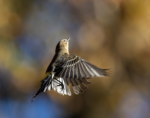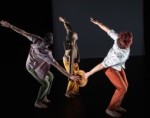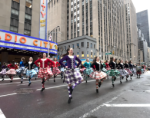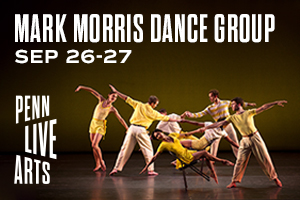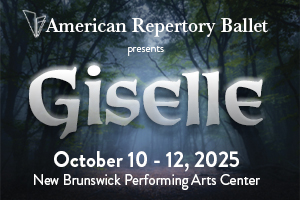
To Us/Because of Us
by Emilee Lord
“The places we dance or make work or share ideas with lovers and strangers are never ours. We guest in these spaces, in the ways that we guest on Earth and in the matter of time.”
- Thomas F. DeFrantz from the poster that opens Dance History(s).
This is not a traditional book. Or, it is a book, but also a pile, compilation, a collection, a record, and an offering. Dance History(s), Imagination as a Form of Study, edited by DeFrantz and Annie-B Parson, is as much a workbook, a toolkit, and a guide for further making as it is a gathering of thoughts. It’s also for dreamers, and people who move their bodies, and for those seeking to understand their own becoming.
The object itself is striking: twelve individually bound booklets, sporting an array of colors and ranging in length from around 15 to 35 pages, come stacked together with a folded poster as their intro. A thick blue band holds the whole unit together. Unfolding the 23” x 32” intro poster reveals a title page featuring a hazy and maybe painted-over photo of pine tree tops. The reverse side contains six columns of text by DeFrantz and scattered collections of little colorful drawings and portraits by Parson, framed and labeled much like a tarot deck.
There are no instructions for where to start, so navigating this stack takes on an intuitive quality: shuffle, feel, hold, peruse, choose. I would take one on the train, stuff one into my everyday bag, and leave another one on my coffee table. The stack is made to be strewn about. Each booklet carries its own mood and mode, feel or angle.
The archive is dynamic: these booklets hold personal and collective histories of lived, discovered, practiced, observed, learned, and embodied dance. They are multiple histories of dance, which are also the histories of bodies, cultures, shared identities, and dream spaces. Some texts are general and sweeping, while others offer a full glimpse into the authors themselves. Together, they conjure narratives of dance’s beginnings and generate future histories for exploring the possible and the provocable. Yet the writings are current, emerging from present day minds of different ages and focuses: live writings from inside the dancer and the dance. The collection features a present tense narrative spanning pandemic response, memory, gratitude, and choice making.
The community is palpable: across all writings, there are shared names, dances, observations, and mentors. There are authors who started with double dutch and social dance, there are those that ended up in the Henry Street Settlement programming. Many studied with the same teachers and choreographers, faced similar setbacks, and celebrated overlapping triumphs. The writers share a dreamscape where innovation and exploration are not just possible but necessary, and where curiosity is key.
As I read, I encounter the challenge of authors translating embodied knowledge into language, of using words to describe and outline the way they learned a non-spoken form. The works speak of conjuring, ritual, exchange, and growth. This is a collection of scores, drawings, instructions, citations, diagrams, plays with format, footnotes, foot work, and poetry. All of the writers trace patterns of dance-making or dance-watching from the beginning, (their own or humanity’s as a whole), pointing to dance as a need as well as a rite.
maura nguyễn donohue writes in Somewhen Else that “Dance is a weed.” This is the final thread I need to tie these writings together. Dance grows no matter the situation; it defies and defines circumstance. Dance comes up where it is seeded, no matter the surface. Dance travels easily like dandelion fuzz taking off on a breeze. It is among us, of us, happening to us. Each individual story of dance-becoming is a journey, intertwined, co-created, multigenerational, and abundant.
Each work deserves its own review, really, its own deep dive and unpacking. In place of that rather daunting task, I leave you with a handful of quotes I’ve been rolling around in my mouth like marbles for a while now. All of this is to say: I think you should shuffle through the stack.
“I don’t believe in history (or at least the story it tells itself), and despite years of working as a choreographer, I still don’t know what dance is. Which is also to say, I don’t know what isn’t dance.” - Andros Zins-Browne in Bring Your Folks
“When did you first witness dance? Where was it? Who or what was dancing? Who or what were they dancing with? How long were you there? Was there music? Can you still hear the music?” - some questions from Ogemdi Ude in Watch me
“...when the metamorphosis of meaning into the materiality of language butchers the beauty of us… I don’t want to write the thing because the thing is the thing and the words are not the thing and the righting the words is not the thing and it’s just writing. I cannot say to anyone what I want to matter…” - maura nguyễn donohue refusing to clearly define dance in Somewhen Else
“It is a folly to attempt to articulate the beginning of anything, but it is righteous for any dancer to claim a history.” - Keith Hennessy in answer to the question of how he started dancing and when in his work A History of Dancing
“It is a book listing an endless trail of begets. It is being written as it is read.” - Okwui Okpokwasili describing her mothers body pregnant with her in Entangled
“It’s helpful to realize that parts of us travel under our skin, arrive by happenstance, take their time to manifest, collide, and then show up.” - Bebe Miller in This Is How Dancing Happens
And Finally, DeFrantz, at the end of the intro, calls on all of us to write our own dance history saying, “There should be a million of these books.”
Dance History(s) Imagination as a Form of Study, Dancing Foxes Press, Co-published with Big Dance Theater and Wesleyan University Press, Edited by Annie-B Parson and Thomas F. DeFrantz, Text by mayfield brooks, thomas f. defrantz, maura nguyễn donohue, Keith Hennessy, Bebe Miller, Okwui Okpokwasili, Eiko Otake, Annie-B Parson, Javier Stell-Frésquez, Ogemdi Ude, Mariana Valencia, and Andros Zins-Browne
Homepage Image Description: Fanned out in a circle on a white surface are 12 booklets in a range of colors. Here and there are sections of text covered or obscured by other booklets. In the center of this circle is the title piece in a wash of brown darker at the bottom and lightening toward the top. The vague image of pine tree tops on its surface. It reads, Dance across the top and History(s) across the bottom with the subtitle Imagination as a Form of Study in the center. Underneath in smaller letters it reads edited by Thomas F. DeFrantz and Annie-B Parson.
Article Image Description: Laid in an overlapping line on a white surface are 12 booklets each in a different bright color. The one farthest to the right and in light blue reads in black text Eiko across the top and Otake across the bottom with the word Letters placed above and to the right of center.
By Emilee Lord
July 29, 2025


